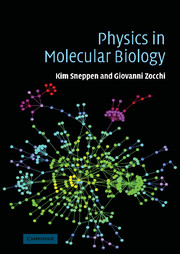Book contents
- Frontmatter
- Contents
- Preface
- Introduction
- 1 What is special about living matter?
- 2 Polymer physics
- 3 DNA and RNA
- 4 Protein structure
- 5 Protein folding
- 6 Protein in action: molecular motors
- 7 Physics of genetic regulation: the λ-phage in E. coli
- 8 Molecular networks
- 9 Evolution
- Appendix Concepts from statistical mechanics and damped dynamics
- Glossary
- Index
8 - Molecular networks
Published online by Cambridge University Press: 06 July 2010
- Frontmatter
- Contents
- Preface
- Introduction
- 1 What is special about living matter?
- 2 Polymer physics
- 3 DNA and RNA
- 4 Protein structure
- 5 Protein folding
- 6 Protein in action: molecular motors
- 7 Physics of genetic regulation: the λ-phage in E. coli
- 8 Molecular networks
- 9 Evolution
- Appendix Concepts from statistical mechanics and damped dynamics
- Glossary
- Index
Summary
Cells are controlled by the action of molecules upon molecules. Receptor proteins in the outer cell membrane sense the environment and may subsequently induce changes in the states of specific proteins inside the cell. These proteins then again interact and convey the signal further to other proteins, and so forth, until some appropriate action is taken. The states of a protein may, for example, be methylation status, phosphorylation or allosteric conformation as well as sub-cellular localization. The final action may be transcription regulation, thereby making more of some kinds of proteins, it may be chemical, or it may be dynamical. A chemical response would be to change the free concentration of a particular protein by binding it to other proteins. A dynamical response could be the activation of some motor, as in the chemotaxis of E. coli.
The presently known regulatory network of yeast is shown in Fig. 8.1. The action of proteins in this network is to control the production of other proteins. The control is done through genetic regulation discussed previously, through control of mRNA degradation, or possibly through the active degradation of the proteins.
Regulatory genetic networks are essential for epigenetics and thus for multicellular life, but are not essential for life. In fact, there exist prokaryotes with nearly no genetic regulation. Figure 8.2 shows the number of regulators as a function of genome size for a number of prokaryotic organisms. One notices that those with a very small genome hardly use transcriptional regulation.
- Type
- Chapter
- Information
- Physics in Molecular Biology , pp. 209 - 244Publisher: Cambridge University PressPrint publication year: 2005



